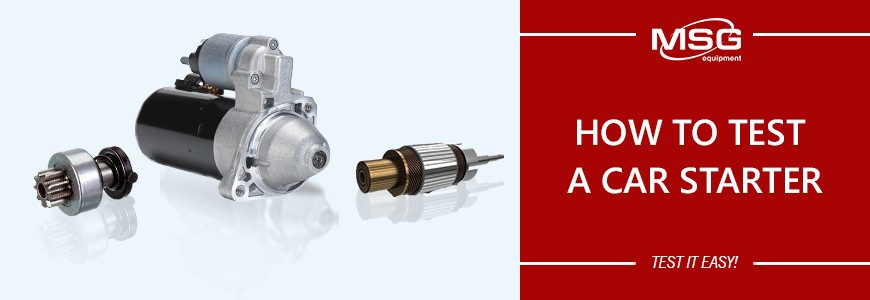
Despite the large variety of models of vehicles, the starters used in them have almost the same design and work on the same principle.
The figure shows starter switching scheme used in the vehicles.

The job of the starter is performed as follows. When the vehicle's ignition is in the Key-yon position, contacts S are being short circuited and the power from battery is supplied to the pull-in 3 and hold-in 4 winding relay at the same time. The armature 5 of the starting relay moves inside the core of the relay and thereby, through rod 6, causes rotation of the lever 7, pushing the other end through the coupling 8, the pinion 10 engaged with a gear wreath of a flywheel 11. At this time the starter motor through the winding 3 receives power from the vehicle battery and starts the rotation with low momentum. When the armature presses the contact plate 2 contact bolts 1, power to the motor 12 is supplied directly through the contacts, bypassing the pull-in winding. The resistance of the power supply circuit of the motor decreases and it develops the maximum speed. The gear 10 through the flywheel gear ring transmits torque to the crankshaft and the engine is started. When the crankshaft turns begin to exceed the speed of the starter, the freewheel clutch comes in 9.
The pinion remains engaged until the contact screws are closed. Also, as can be seen from the figure, the pull-in and hold-in winding, when the contact S is open, are connected to the battery coherently. And since they have a different winding direction, but the same number of coils, they generate magnetic fluxes of equal magnitude, but opposite in direction, thus neutralizing each other. The contact plate under the influence of the spring moves to the right and breaks the circuit at the same time acting on the lever 7 and moving the gear out of engagement with the flywheel.
How to check the starter without removing it from the vehicle
Let's look at common signs of a starter's fault and learn how to test a starter at home.
Switching on the starter and then switching off spontaneously can be accompanied by clicks of the relay of inclusion or the solenoid starter switch relay of a starter. The main reasons for this problem include:
- Defective or discharged battery.
- Low temperature the environment.
- Oxidation of the wire contacts, as well as their loose attachment to the terminals of the battery, the solenoid starter switch and the car body.
- Malfunction of the relay of inclusion and-or the solenoid starter switch of a starter.
As you know, reducing the temperature of the electrolyte to -20 ° C leads to a decrease in battery capacity by 20%. Also at low temperatures, the viscosity of the electrolyte increases, which prevents its contact with the active mass of the electrode plates and thereby reduces the voltage at the battery terminals. On this basis, it will be difficult to test the starter on the battery in a low temperature environment. f we take into account the possible oxidation of the contacts on the terminals of the connecting wires, then the reasons for the spontaneous starter switching-off become clear.
Next, assess the degree of oxidation of contacts by measuring the voltage on the battery terminals and the terminal of the solenoid starter switch, and the starter housing at rest, and then when the starter is turned on for 3-4 seconds. The difference in the measured readings should not exceed 1.5 V (optimally, that they are the same). It should be remembered that the voltage on the terminals of a working 12-volt battery should be greater than or equal to 10 V. For a 24-volt battery, the voltage drop should not exceed 4 V (i.e., UACB≥20 V). Otherwise, it is necessary to clean and check the strength of the terminals of the power wires.
Solenoid starter switch
The solenoid starter switch functions are as follows:
- Engagement of the drive gear of the starter motor with the flywheel of the engine.
- Short circuit power supply starter motor.
Although the solenoid starter switch of different manufacturers differ in the number of windings, the way of fixing on the starter, the design of the contact terminals, they all have the same functions and the principle of operation similar to that of a conventional solenoid.

If you look at the section of the solenoid starter switch in the figure above, you can see that it contains two solenoid windings (hold-in 13 and pull-in 14), screwed onto a brass bushing, where the armature 11 moves and rod-actuated 15 with the movable contact disk 4. Two immovable contact bolts are fixed in the plastic cover 2. The contact disk can be of various shapes (rectangular, round or shaped) and is insulated from the rod. One of the most common problems in this contact pair is the ignition of the contacts or their welding. This is the first reason why it is not recommended to keep the starter on for more than 5-6 seconds, the second is the accelerated discharge of the battery.
How to check the starter relay
To check the solenoid starter switch, you must connect its terminals to the battery, observing the polarity. If the device is working properly, the starter gear will move and you will hear characteristic clicks.
On our YouTube channel there is a video clip, which you will learn how to check the starter with a multimeter (using ordinary clamp mites) with a car battery, and also localize the cause of the malfunction.



COMMENTS